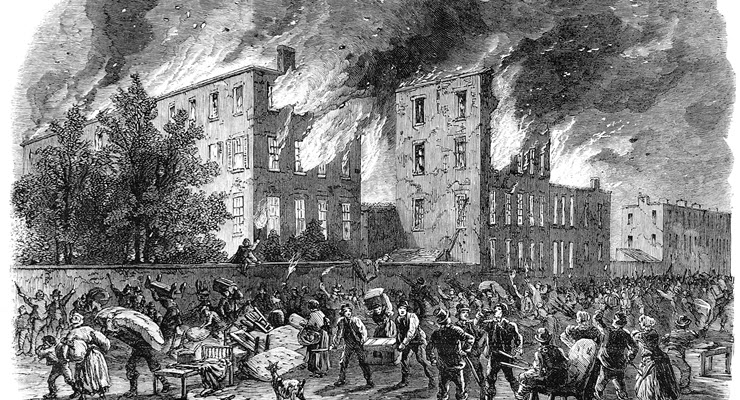
After the storming of the US Capitol yesterday came the old refrain: “This is not who we are“.
The phrase isn’t just morally frivolous (just how many mass shootings or neo-Nazi rallies have required its deployment in the past four years alone?). It’s also factually incorrect.
While this is the first time a coup has been attempted at the behest of a president, it’s only the latest episode in America’s violent and revolutionary history.
New York City draft riots
The US managed the largest popular insurrection in its history right in the middle of its deadliest war (only in America, folks!).
The draft riots began on July 13, 1863 in New York, initially in response to the clear class-based inequities of a strict new conscription law.
Under the Civil War Military Draft Act, there were two ways to legally dodge the draft. You could hire a substitute to fight for you, or buy your way out for $300. Thousands of workers, largely Irish, poured into the streets to protest.
The demonstration quickly turned violent; the mob stormed the draft office and beat the police superintendent unconcious. But the riot was as much motivated by race as it was class — many of the rioters viewed free Blacks as competition for jobs and in some cases (stoked by Democrat politicians in the north) even blamed them for the war.
So when things turned violent, much of that violence was directed towards the Black community; during the four days of chaos, the mob turned on freed slaves, and beat to death and lynched Black men. A Black orphanage and church were burned down.
Bread riots
In April, 1863 a group of “armed, half-starved women” stormed the Virginia state Capitol, demanding to speak to governor John Letcher and sparking the bread riots.
The south’s supply lines had been choked off by a Union blockade, made worse by a snow storm that March. Indeed, the Virginia riot was just the largest of many in response to food deprivation across the southern states.
After an unsatisfactory response from Letcher, the women, armed with axes, knives, and other weapons, marched through the city, ransacking government warehouses for food. Their numbers swelling, they chanted “bread or blood”.
The riot finally ended after the public guard arrived and threatened to open fire on the crowd. Around 60 people were arrested, and the city installed artillery in key areas of the city as a warning against future uprisings.
Anti-reconstruction uprisings
In fact, there have been so many uprisings over the course of US history, we’ve had to skip quite a few (sorry to all you Nathaniel Bacon and John Brown fans out there).
Twice in late 1874, the White Man’s League (a white supremacist terrorist organisation formed out of the southern Democratic Party who operated openly and frequently sought out media coverage for its views) tried to interfere in elections in Alabama and Louisiana.
In Alabama it seized polling places and county offices, killed at least seven Black Republicans (at least 70 more were injured) and intimidated others away from voting or burned their ballots. It worked. Black voters stayed away from the polls and anti-reconstruction Democrats regained control of the state government.
This followed the three-day occupation of the Louisiana state house and armory by the league, as it attempted to overthrow the Republican government and reinstall John McEnery, a white supremacist who refused to concede his defeat in the gubernatorial election two years earlier.
While they eventually were forced to retreat, it ultimately worked, in effect bringing to an end to reconstruction policies in the state.
Wilmington coup
The last successful coup in the United States happened on November 10 1898 when white supremacists overthrew the city government of the majority Black city of Wilmington, North Carolina. It followed years of race-baiting from the Democrats, echoed and amplified by local partisan media.
The insurrection started with the mob burning down the office of Black-run newspaper The Daily Record, and would eventually result in the killing of an unknown number of Black residents.
The mayor, the alderman and the chief of police were forced to resign while prominent members of the Black community (along with unsympathetic whites) where expelled by threats or physical removal.
The mob went on to alter the law to disenfranchise Black voters for generations, dropping enrolment numbers from over a 100,000 to less than 10. No one was ever prosecuted.
A review of David Zucchino’s Wilmington’s Lie notes: “The plan was hatched in secret, but the conspirators were remarkably open about the coup once it began. A reporter from out of town marvelled, ‘what they did was done in broad daylight’.”








As a summary of community violence the article serves well enough. Considerably more could be added by way of examples but the history of what gave effect to the instances are much more interesting and which you have chosen to ignore.
Take a look at a map by State of voting for presidential elections from the 1890s or the turn of the century. There is a discernible colour switch to the present pertaining to the country as a whole.
White supremacists seem to be a common thread.
The purchase of a slave was never a cheap exercise and it was in one’s interest to look after them. Many of the plantations have been “refurbished” complete with staircase entrances; Right and Left (for males, aged 14 or more, and females). Literally thousands of letters exist (French, [improvised] Creole and English) and many have been incorporated into books.
There was NOT one person in the world over the age of eight years (minimum age for ‘mens rea’) who did not know his place and hence his social standing in (e.g) 1850. Such a state of affairs continued until just. after WW1.
The laws enacted by the Republicans during the period of Reconstruction are a matter of record. In particular, former officers of the Confederacy were disenfranchised to say nothing of the taxes; many revoked as unconstitutional but damage had been DONE. Social events do have origins.
The white stuff is a tacky “add on” even by its contemporary adherents. Of course there was the George Wallace mentality but for those seeking a tutorial try Asia or any of the African States.
Wouldn’t be another “non-thinking” comment eh DB?
Sorry : as a conjecture, the explanation likely resides with your acknowledged contempt for history.
American Exceptionalism as ever.
Violence is as American as cherry pie.
Born in blood & genocide, theft and rapine.
They found a garden and made it a wilderness.
Reminds me of another country, now that I think of it.
Except that the protest was a display of amateurish dithering and, ipso facto, hardly violence. I have prepared something for tomorrow because I anticipate nine yards of flannel from someone at Cky.
To the larger picture, Agni, you are correct. Per capita homicide in the USA is 10x than that of Canada for roughly the same legislation.
Only a few years ago I asked someone in sociology at one of the universities (Berkeley?) the reason for acts of violence receiving sentencing nowhere near as severe as offences relating to censorship or to “indecent” statements in publications to about 1980.
Two embargoed posts of mine (innocent as all hell) await you tomorrow. I mention it should they disappear into the aether; not likely but not impossible either.
I also have two re your posts, getting on for 48hrs now.
It really behooves the Censor to explain why – I defy anyone to find a reason to have tripped the ModBot.
Whenever the dread orange lettered Awaitening pops up I make a point of copying the ”offending” piece to documents – you’d be surprised how often they just evaporate into the ether.
The grammar is incorrect. The message ought to read “awaiting…” – – OR– “waiting for….” but NOT a combination of the two. Such has been the case for months.
The editorial staff can’t manage simple grammar so it’s overly optimistic to imagine the tekky hamsters having a clue.